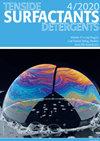二酯酰胺双子表面活性剂与聚合物之间的相互作用及其在染发剂中的应用
IF 1.2
4区 工程技术
Q4 CHEMISTRY, APPLIED
引用次数: 0
摘要
本研究采用表面张力法研究了二酯酰胺双子座表面活性剂(C12-E2Ph-C12)与平均分子量分别为 6000 g mol-1 和 10,000 g mol-1 的非离子聚合物聚乙二醇(PEG)之间的相互作用。研究结果表明,它们之间没有明显的相互作用。为了进一步研究 C12-E2Ph-C12 和阴离子聚合物海藻酸钠(NaAlg)之间的相互作用,还使用了表面张力法、微极性法和浊度法。在静电吸引的作用下,C12-E2Ph-C12 和 NaAlg 分子结合在一起,形成具有珍珠项链状结构的聚集体。这种相互作用在表面张力和微极性曲线上都很明显,出现了双高原。无机盐 NaCl 对 C12-E2Ph-C12 和 NaAlg 之间的相互作用具有双重影响,根据它们的竞争效应,表现为增盐或减盐。此外,还使用色度计研究了不同表面活性剂对两种染料的染色性能。结果表明,C12-E2Ph-C12 对染色均匀性、色牢度和头发抗拉强度的改善都有良好的效果。在染发剂配方中加入 C12-E2Ph-C12 作为均匀染色剂,并使用 NaAlg 作为增稠剂时,染发效果令人满意。本文章由计算机程序翻译,如有差异,请以英文原文为准。
Interactions between diester amide Gemini surfactants and polymers, and their application in hair dyes
In this study, the interaction between a diester amide Gemini surfactant (C12 –E2 Ph–C12 ) and the non-ionic polymer polyethylene glycol (PEG) with average molecular weights of 6000 g mol−1 and 10,000 g mol−1 was investigated using the surface tension method. The study showed no discernible interaction between them. Further examinations, using surface tension, micropolarity and turbidity methods were conducted to investigate the interaction between C12 –E2 Ph–C12 and the anionic polymer sodium alginate (NaAlg). C12 –E2 Ph–C12 and NaAlg molecules bind together to form aggregates with a pearl necklace-like structure, driven by electrostatic attraction. This interaction is evident in both the surface tension and micropolarity curves, where double plateaus appear. The inorganic salt NaCl exhibited a dual influence on the interaction between C12 –E2 Ph–C12 and NaAlg, manifesting as either salt enhancement or reduction, depending on their competitive effects. Additionally, the dyeing performance of the different surfactants on two types of dyes was investigated using a colorimeter. C12 –E2 Ph–C12 showed favorable effects on dyeing uniformity, color fastness, and improvement of hair tensile strength. Hair dyeing results were satisfactory when C12 –E2 Ph–C12 was included as a uniform coloring agent and NaAlg was used as a thickening agent in the hair dye formulation.
求助全文
通过发布文献求助,成功后即可免费获取论文全文。
去求助
来源期刊

Tenside Surfactants Detergents
工程技术-工程:化工
CiteScore
1.90
自引率
10.00%
发文量
57
审稿时长
3.8 months
期刊介绍:
Tenside Surfactants Detergents offers the most recent results of research and development in all fields of surfactant chemistry, such as: synthesis, analysis, physicochemical properties, new types of surfactants, progress in production processes, application-related problems and environmental behavior. Since 1964 Tenside Surfactants Detergents offers strictly peer-reviewed, high-quality articles by renowned specialists around the world.
 求助内容:
求助内容: 应助结果提醒方式:
应助结果提醒方式:


